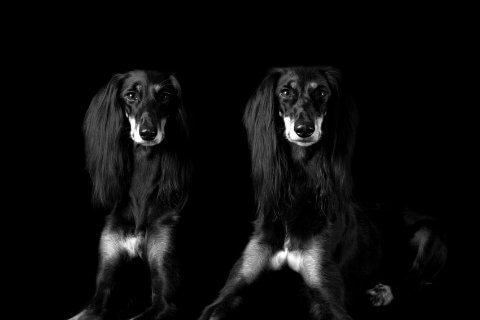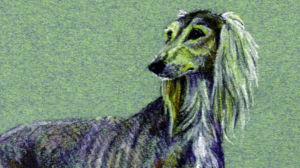
Judging Salukis
Gain insights into judging Salukis, a breed celebrated for its grace, speed, and enduring hunting prowess. Learn more.
Home » Meet The Breeds » Saluki
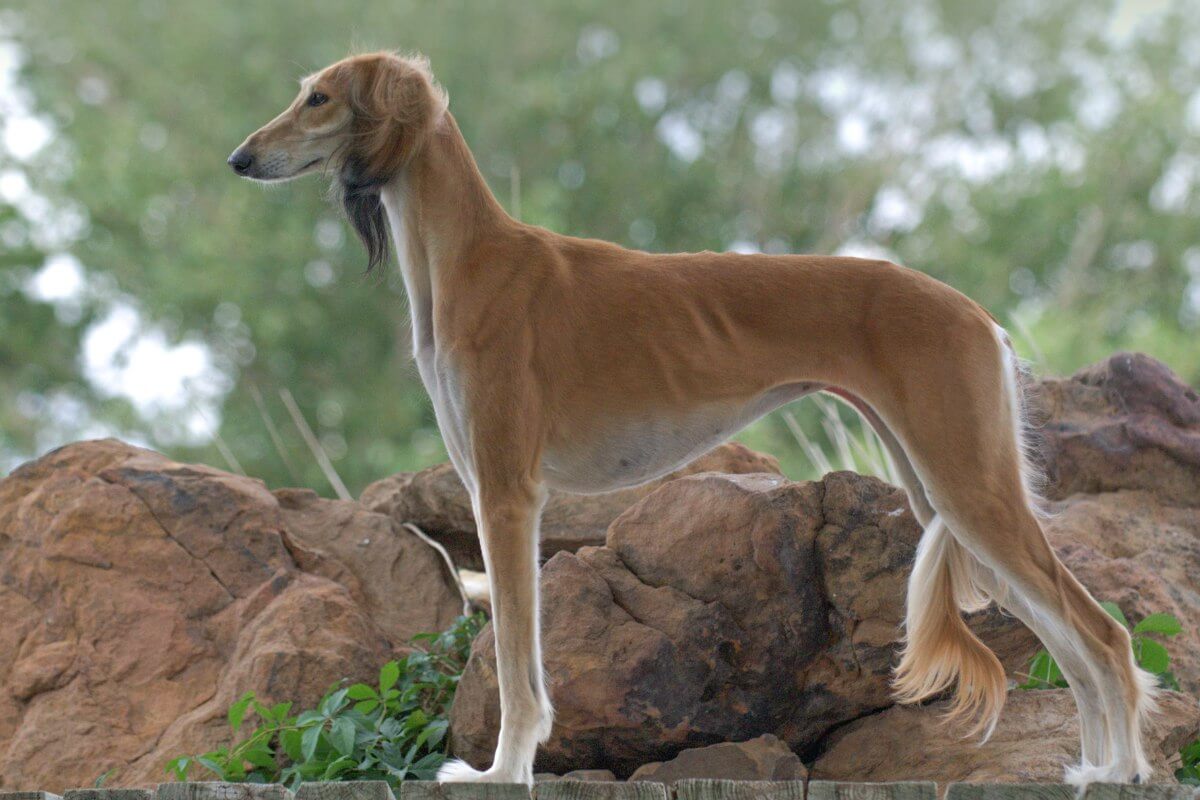
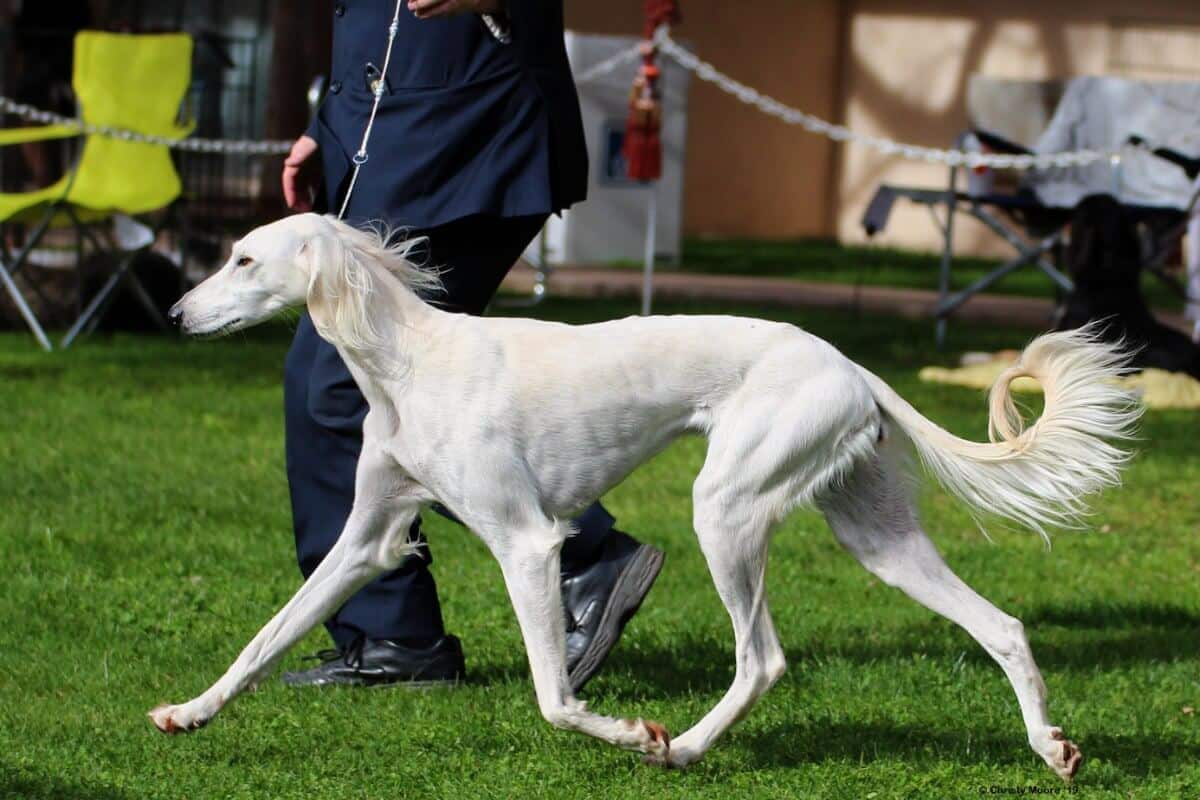
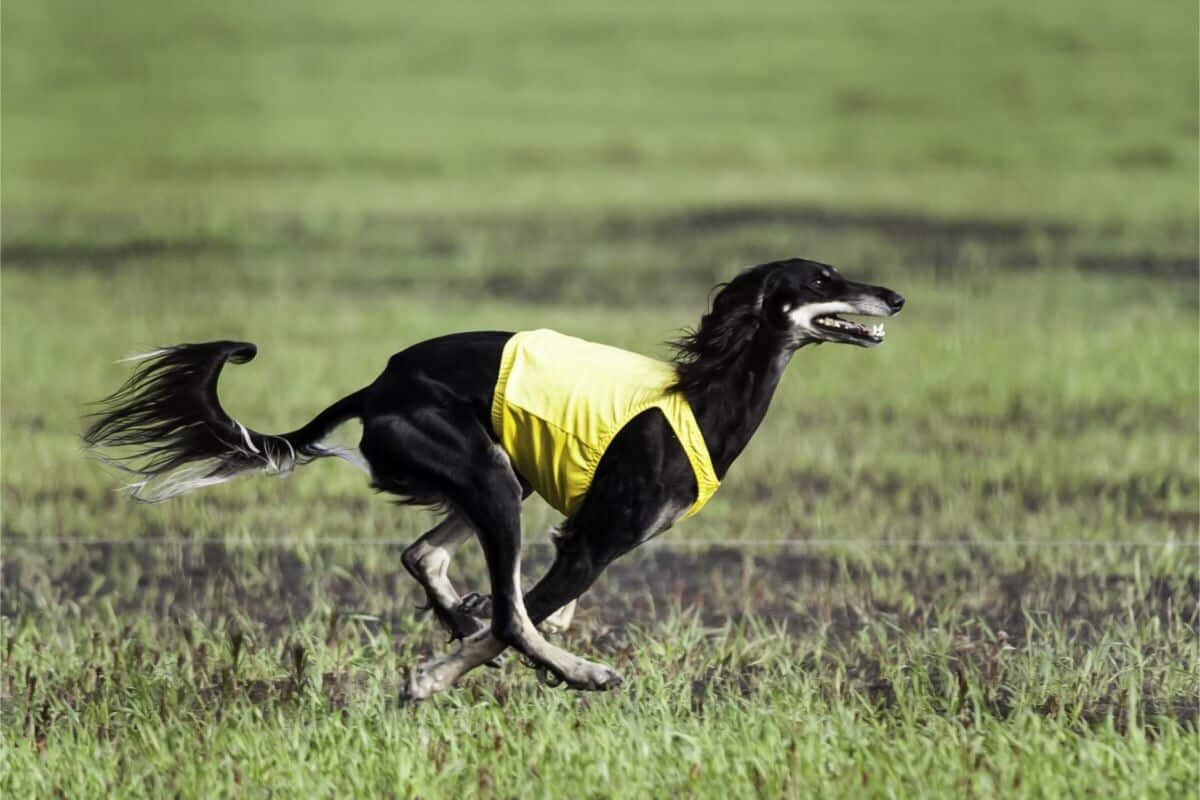
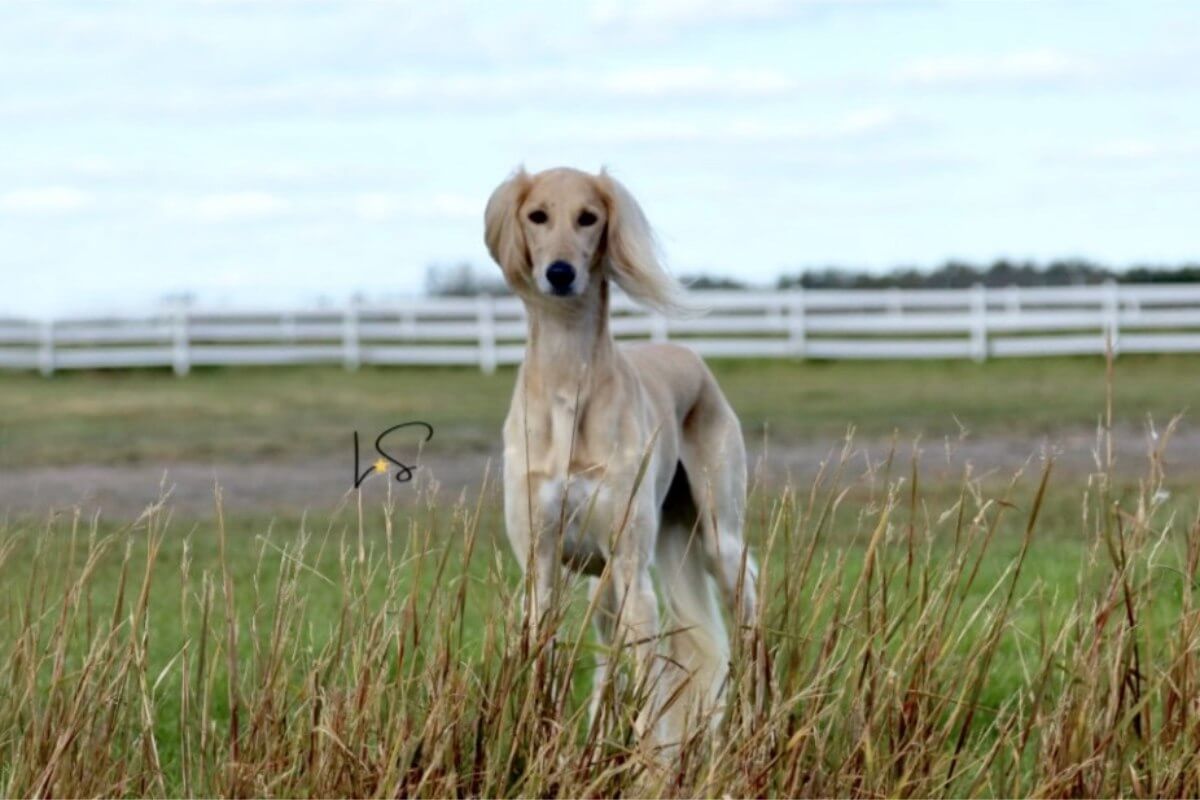
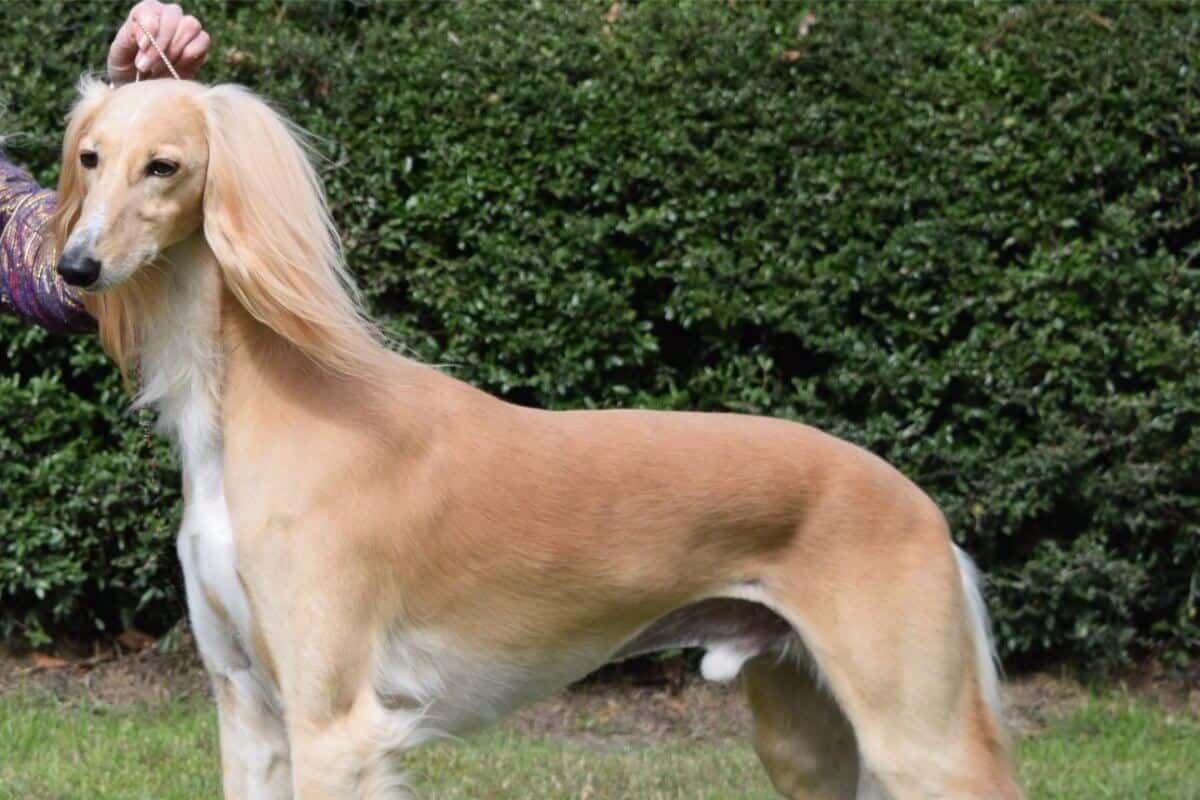
The Saluki, often referred to as the “Royal Dog of Egypt,” is one of the oldest known breeds of domesticated dogs. Graceful, swift, and elegant, this sighthound embodies a rich history intertwined with the ancient civilizations of the Fertile Crescent. The Saluki is renowned for its incredible speed and endurance. These qualities made it an ideal companion of the Bedouins for centuries just as it has made it a reliable competitor in many dog sports today.
Hound
23 – 28 Inches
40 – 65 Pounds
10 – 17 Years
| Country of Origin | Egypt, Iraq, Iran |
|---|---|
| Bred For | Hare and Gazelle and Hunting, Companionship |
| Known For | Grace, Speed, Symmetry |
| Popularity | Moderate |
| Temperament | Dignified, Gentle, Independent |
| Activities | Coursing, Running, Hiking, Conformation Shows, Dog Sports |
Regarded as one of the oldest dog breeds in existence, the history of the Saluki is scattered across the sands of time. These origins of these graceful hounds can be traced back to the ancient civilizations of the Middle East. Carvings and cave paintings depicting Saluki-like dogs have been discovered at several archaeological sites in the region of Sumer, which is present-day southern Iraq, some of which date back to 2100 B.C.
The Saluki, often referred to as the “Royal Dog of Egypt,” held a place of high esteem in ancient Egyptian society. Historical evidence suggests that these dogs were considered to be gifts from the gods and they were revered as such. Pharaohs and other royals often had their Salukis mummified and buried alongside them so the hounds could accompany their masters in the afterlife.
The nomadic Bedouin tribes of the Middle East held the Saluki in similar regard. For them, the breed was more than just a companion; it was a skilled hunter, essential for their survival in a harsh environment. Using their remarkable speed and sight, Salukis were adept at hunting gazelle, hare, and other desert fauna.
The breed’s name, “Saluki,” is believed to have originated from the ancient city of Saluk, in Yemen. However, other theories suggest it might derive from the Arabic word “Saluqi,” which refers to something hailing from the Arabian city of Seleucia.
Introduced to Europe in the late 19th century, the Saluki quickly gained popularity, especially in England. Their elegant appearance, combined with their hunting prowess, made them a favorite among the British elite.
The Saluki has garnered respect and recognition from leading kennel organizations across the world. The Royal Kennel Club (UK) granted it official status in 1923. This was followed by the American Kennel Club, which recognized the Saluki in 1929. Later, the Fédération Cynologique Internationale (FCI) added its seal of approval in 1966. Today, the Saluki occupies a cherished position in the sport of dogs, underscoring its rich heritage and widespread admiration.
The breed’s enduring legacy, spanning thousands of years, is a testament to its timeless allure and exceptional qualities. As both a companion and a hunter, the Saluki continues to captivate hearts and minds wherever it is found.
In terms of height, adult male Salukis typically stand between 23 and 28 inches tall at the shoulder. Mature females are typically shorter in stature.
When it comes to weight, both males and females usually range from 40 to 65 pounds.
The Saluki is the embodiment of grace and symmetry. The breed’s slender, elongated frame is well-proportioned, suggesting both strength and elegance. This sighthound is defined by its lightness and its swiftness. Its body is moderately deep, with a gently curved topline and a slight arch over the loin. When the Saluki is in motion, it is impossible not to be captivated by this sighthound’s effortless, fluid gait, a testament to its hunting heritage.
Texture: The Saluki has two coat types: smooth or feathered. Both variations are silky to the touch, exuding an air of elegance and refinement. The length of the smooth coat is consistently short over the body, although a slight “brush” on the tail is acceptable. The coat of the feathered variety, however, may vary in length from quite short to several inches in length. The hair is longer on the ears, neck, tail, back of the forelegs and thighs, between the toes, and sometimes on the thighs and shoulders, giving it a distinctly elegant appearance. Puppies can have “puppy fuzz” over the body, which generally disappears with the arrival of the adult coat. Adult Salukis, particularly the males, can have a neck ruff of longer hair.
| Standard Color | |
|---|---|
| Black & Tan | ee |
| Black Tan & White | ee |
| Cream | ee |
| Fawn | ee |
| Golden | ee |
| Red | ee |
| Silver | ee |
| White | ee |
| Chocolate | ee |
| Chocolate & Tan | ee |
| Black | ee |
| Black & Silver | ee |
| Standard Marking | |
|---|---|
| Parti-Color | ee |
| Sable | ee |
| Grizzle Markings | ee |
| Irish Marked | ee |
| Irish Marked Grizzle | ee |
| Parti-Color Grizzle | ee |
| Irish Marked Sable | no |
| Sable Parti-Color | no |
A Note About Color: Color is immaterial in the Saluki; however, brindle is a coloration that is not desired in the breed.
The tail of the Saluki is long, set low, and carried naturally in a gentle curve. When the Saluki is in motion or excited, the tail may be elevated but doesn’t curl over the back. It is well covered with hair, especially in the feathered variety where the hair is more pronounced, giving it a plume-like appearance. The tail’s length and flexibility allow the Saluki to use it as a rudder during high-speed chases, aiding in balance and quick changes in direction.
Choosing to bring a Saluki into the home is a commitment to understanding and appreciating a breed with ancient roots and unique needs. These hounds, referred to as the “Royal Dog of Egypt,” possess a blend of grace, speed, and endurance, but with their regal appearance, they also come with specific responsibilities for their handlers and caretakers.
The Saluki is generally considered a robust and resilient breed, inheriting the lineage of a desert hunter built for stamina and speed. However, as with any dog, individuals can be prone to certain health issues.
Lifespan: The average lifespan of a Saluki is around 10 to 17 years. With attentive care, many Salukis live comfortably in their golden years, still showcasing the grace and elegance that has been a hallmark of the breed for centuries.
Like all breeds and mixed breeds, the Saluki is not immune to a few health concerns. Some of the more common risks associated with the breed include:
It is worth noting that while these issues can occur, they aren’t guaranteed to affect every Saluki during their lifetime. Regular veterinary visits, and a good relationship with the dog’s breeder, are paramount for early detection and management of any health issue.
The Saluki is a breed renowned for its dignified demeanor and ancient heritage. While these dogs have a reserved nature, they form deep bonds with their human companions, showcasing a loyalty that is both profound and enduring. They aren’t typically suited for novice owners, however, as their independent spirit requires an understanding and patient caretaker who can appreciate and manage the hound unique traits.
Salukis have a moderate sensitivity level, which means they can be affected by their environment. Sudden changes can stress them out. These sighthounds cherish their quiet time and might not appreciate a chaotic household. However, this sensitivity also translates to their being incredibly intuitive and empathetic companions, often attuned to their human partner’s emotions.
When it comes to socialization, Salukis typically exhibit selective behavior. They can be aloof with strangers, taking their time to warm up. However, once they decide someone is trustworthy, they can be quite affectionate. As for other dogs, they generally get along well, especially if they’ve been raised together. The Saluki’s history as a hunting dog means it has an inherent pack mentality, but introductions to unfamiliar dogs should still be done with care.
The Saluki tends to be gentle with children, especially if it has been raised with them. The breed’s calm disposition makes these hounds particularly good companions for older kids. However, due to their somewhat reserved nature, it is always a good idea to supervise interactions with very young children, and to teach the kids how to approach and handle the dog appropriately.
Feeding a Saluki appropriately requires an understanding of their unique nutritional needs, which are shaped by their athletic build and historical role as desert hunters. The energy requirements of a Saluki can vary based on their age, activity level, and individual metabolism.
When it comes to Saluki puppies, their rapid growth means they need a diet rich in essential nutrients. High-quality puppy food is crucial during this phase to support their developing bones and muscles. Splitting their daily food intake into multiple smaller meals can aid digestion and prevent overeating.
As Salukis transition into adulthood, their dietary needs change. Adult Salukis, depending on their activity level, typically require a balanced diet formulated for medium to large breeds. It’s essential to monitor their weight and adjust their food portions accordingly to prevent obesity, as an overweight Saluki can face numerous health issues.
The average Saluki might consume between 2 to 2.5 cups of high-quality dog food daily, split into two meals. However, it’s always wise to consult with a veterinarian regarding the specific amount, as factors like age, activity level, and health can influence their dietary needs.
Fresh water should always be accessible to Salukis. Their slender build and active nature mean they can get dehydrated quickly, especially in warmer climates. Regularly checking their water dish and keeping it clean ensures they remain hydrated and healthy.
Training a Saluki can be both a rewarding and challenging endeavor due to their independent and sometimes aloof nature. These dogs are intelligent, but they possess a free spirit that hails from their long history as desert hunters. This means that while they can grasp commands and lessons quickly, they might also choose when to obey based on their mood or distractions in their environment.
Salukis aren’t known for excessive barking. However, if left alone for extended periods or if they become bored, they might vocalize their displeasure. Providing them with enough mental and physical stimulation can mitigate such behaviors.
Their intelligence is undeniable. Salukis are quick learners and can excel in obedience training if it’s made engaging for them. Positive reinforcement methods, such as treats or praise, often work best with this breed. Harsh training methods or scolding can be counterproductive, causing the Saluki to become more reserved or even distant.
A trait to be mindful of is their strong prey drive. Salukis have an innate desire to chase, stemming from their days as hunting dogs in the deserts of the Middle East. This means they might be tempted to chase smaller animals, and having them off-leash in an unfenced area can be risky.
Salukis are not typically prone to wandering, but their curiosity and hunting instincts can sometimes get the better of them. Secure fencing and a watchful eye during outdoor activities can help manage this trait.
The exercise needs of Salukis reflect their historical role as swift and enduring desert hunters. Although they’re often described as laid-back and even couch-loving indoors, the outdoors transforms them, revealing their true athletic nature. Salukis appreciate the freedom to stretch their legs and enjoy a good sprint, taking advantage of their incredible speed.
| Energy Level | Moderate to High |
|---|---|
| Exercise Requirements | 2 Hours/Day (Minimum), Daily Walks, Vigorous Running, Regular Daily Exercise, Playing with Another Dog, Mental Stimulation |
Their energy level is moderate to high. While they cherish their relaxation moments indoors, they equally relish regular opportunities to run. This breed benefits from a combination of structured exercises, such as daily walks or jogs, and unstructured playtime in a safely enclosed area where they can sprint to their heart’s content.
The intensity of the exercise can vary based on their age and overall health. Younger Salukis might have bursts of energy, requiring more frequent play sessions, while seniors might be content with more leisurely walks and shorter playtimes.
Playfulness is a characteristic trait of Salukis, especially during their younger years. Engaging them in interactive games, like fetch or agility training, not only caters to their exercise needs but also strengthens the bond between the dog and their human companion.
It’s worth noting that due to their slim build and thin coat, Salukis can be sensitive to extreme temperatures. On very hot days, it’s best to exercise them during the cooler hours of the morning or evening. Similarly, in cold weather, they might require protective clothing to keep them comfortable.
The coat of the Saluki, while elegant and silky, doesn’t demand an overly complex grooming routine. Nonetheless, regular maintenance is essential to keep them looking their best and to ensure their skin and coat remain healthy.
| Coat Type | Smooth, Silky, Soft |
|---|---|
| Grooming Requirements | Weekly Brushing, Occasional Bathing, Routine Ear Cleaning, Periodic Nail Trimming, Regular Tooth Brushing |
Salukis possess a smooth coat on most parts of their body, complemented by feathering on their ears, tail, and sometimes legs. This feathering, while adding to their regal appearance, can get tangled or matted if not attended to. Regular brushing, about two to three times a week, with a soft-bristle brush or a pin brush, can help in detangling the feathering and removing any loose hair or debris.
Shedding in Salukis is typically low to moderate. While they don’t shed excessively like some breeds, periodic shedding is natural. Regular brushing not only keeps their coat in top condition but also minimizes the amount of hair they leave around the home.
Bathing a Saluki doesn’t have to be frequent. Given their thin coat and skin, it’s crucial not to strip their natural oils, so bathing should be done only when necessary, perhaps once every few months or if they get particularly dirty. When bathing, always use a dog-specific shampoo that’s gentle on their skin.
Apart from coat care, other grooming essentials include regular nail trimming, ear cleaning, and dental care. Salukis, like all breeds, can develop ear infections if moisture or debris accumulates in their ears. Checking and cleaning their ears weekly with a vet-approved solution can help prevent this. Additionally, dental hygiene practices such as brushing their teeth or providing dental chews can aid in maintaining good oral health.
The Saluki is a breed of contradictions. Inside the home, they present as refined and reserved, often seeking the most comfortable spot on the couch or bed. However, given their natural instincts, they come alive outdoors, showcasing their inherent athleticism and zest for life. For those sharing their lives with a Saluki, understanding and accommodating these dual aspects of their nature is essential.
When it comes to apartment living, Salukis can adjust quite well, provided their exercise needs are met diligently. Their generally calm and quiet demeanor indoors makes them suitable for such living arrangements. Still, they will need access to a safe open space where they can run and express their athletic tendencies. Ensuring they get the physical activity they need is crucial to prevent potential behavioral issues borne out of pent-up energy.
Salukis have a short, fine coat and lack an undercoat, making them more sensitive to extreme temperatures. In colder weather, they may require some protective clothing, like a coat or sweater, to keep them warm during outdoor excursions. Similarly, during hotter periods, it’s wise to restrict their outdoor activity to cooler parts of the day, like early mornings or late evenings, to prevent overheating.
As previously mentioned, this breed values comfort. Soft bedding or a plush dog bed will be greatly appreciated by a Saluki. They enjoy their relaxation time and will often seek out the softest spot in the house to lounge.
The allure of Saluki puppies is undeniable. With their soft, innocent expressions and playful antics, they can melt the heart of any onlooker. However, raising a Saluki puppy requires understanding and patience, as the foundation laid during the early months can significantly influence a puppy’s development towards becoming a balanced, well-behaved adult.
Bringing a Saluki puppy into one’s home is an exciting time, but it is also a period of significant responsibility. Each puppy is full of energy and curiosity, eager to explore its surroundings and engage with new family members. To ensure a pup grows up to become healthy and well-adjusted, certain aspects of its care need to be considered.
Nutrition plays a vital role in the development of a Saluki puppy. A balanced diet that is formulated specifically for the needs of growing puppies is crucial. This provides the essential nutrients required for rapid growth and development. Regular consultations with a veterinarian can help to determine the best dietary choices while monitoring the puppy’s progress.
Socialization is another cornerstone of puppy care. The Saluki pup benefits immensely from early and varied social experiences. Exposing it to different environments and people, as well as other animals, in a controlled and positive manner can help to shape its temperament, making the hound more adaptable and confident as an adult.
Training should commence from a young age. While the Saluki is intelligent, the breed also has an independent streak. Using positive reinforcement techniques, such as treats and praises, can aid in building a strong bond while ensuring the puppy responds well to commands. Basic obedience training is important, and as the puppy grows, more advanced training can be introduced that recognizes to the breed’s innate temperament.
Regular veterinary check-ups are essential to monitor the Saluki puppy’s health and to ensure it receives timely vaccinations and preventive care. Being proactive in addressing any health concerns can make a significant difference in the puppy’s growth and development.
Salukis, with their inherent athleticism and grace, naturally excel in a variety of Performance events. Participation not only offers an excellent outlet for the hounds’ energy, it also strengthens the bond between the Saluki and its handler. Some of the dog sports enjoyed by Salukis include:
For those interested in exploring these activities with their Saluki, it’s essential to start with proper training and ensure that any sport or event chosen is enjoyable and safe for the dog. Participation not only provides physical exercise but also mental stimulation, ensuring a well-rounded and fulfilled Saluki.
The Saluki is recognized by the world’s leading registries and kennel organizations, which categorize the breed into a specific Group based on its unique characteristics. This breed is recognized worldwide under the following Group designations:
| Organization | Group Designation |
|---|---|
| AKC (American Kennel Club) | Hound |
| UKC (United Kennel Club) | Sighthound and Pariah Dog |
| CKC (Canadian Kennel Club) | Hounds |
| ANKC (Australian National Kennel Council) | Hounds |
| RKC (The Royal Kennel Club) | Hound |
| FCI (Fédération Cynologique Internationale) | Group 10: Sighthounds; Section 1: Long Haired or Fringed Sighthounds |
The ideal Saluki is described by a Breed Standard that is approved by each of the world’s leading registries and kennel organizations. The Breed Standards for this breed may be found in the following links:
| Organization | Breed Standard |
|---|---|
| American Kennel Club | AKC Saluki Breed Standard |
| United Kennel Club | UKC Saluki Breed Standard |
| Canadian Kennel Club | CKC Saluki Breed Standard |
| Australian National Kennel Council | ANKC Saluki Breed Standard |
| The Royal Kennel Club | RKC Saluki Breed Standard |
| Fédération Cynologique Internationale | FCI Saluki Breed Standard |
The Saluki, with its rich history and majestic appearance, has captured the hearts of many, leading to the formation of several dedicated clubs around the globe.
In the United States, the Saluki Club of America (SCOA), established in 1927, is the premier organization for Saluki enthusiasts. It has a longstanding commitment to promoting and preserving the breed, providing guidelines for responsible breeding and ownership. Through the years, SCOA has hosted numerous events, with the annual National Specialty being a highlight. Their focus on Saluki health, training, and more has been invaluable for many breeders and owners.
In Canada, admirers of the Saluki came together in 1962 to form the Saluki Club of Canada (SCC). This organization mirrors the dedication of its American counterpart, championing the well-being, standardization, and overall appreciation of the Saluki in Canada. The SCC plays a vital role in creating a community among breeders, owners, and fans of the breed in the country.
The Saluki or Gazelle Hound Club, having been founded as early as 1923, is the oldest and most renowned Saluki club in the UK. Throughout its storied history, the club has been at the forefront of maintaining the breed’s standard and advocating for responsible Saluki ownership in the region.
For anyone charmed by the Saluki, these clubs provide not only a treasure trove of knowledge but also a warm and welcoming community.
The Saluki sometimes finds itself in situations of distress or need. In response to these challenges, dedicated rescue groups have emerged, ensuring the welfare and protection of this noble hound.
In the United States, the Saluki Club of America serves as a resourceful platform for the breed. While they do not directly facilitate adoptions on their website, they are proactive in guiding individuals to appropriate rescue groups or local Saluki clubs that can provide further assistance and information about the breed.
In the United Kingdom, the Saluki Welfare Fund stands as a prominent organization committed to the rescue and rehoming of Salukis. With the support of dedicated volunteers and foster homes, they play a pivotal role in ensuring the well-being of Salukis in the region.
Beyond these groups, local shelters and general animal rescue organizations sometimes come across Salukis in need of homes. These organizations play a vital role in rescuing, rehabilitating, and rehoming countless animals, including the occasional Saluki.
Salukis are generally considered low-shedding dogs. While they do shed, the amount is much less compared to many some other breeds. Regular grooming helps to remove any loose hair and to keep the silky coat in top condition.
Salukis are renowned for their incredible speed and endurance. They can reach speeds of up to 40 miles per hour, making them one of the fastest of all dog breeds. Their speed, combined with their stamina, allowed them to excel as hunters in open, desert terrain.
Salukis can make excellent pets for the right households. They are known for their sensitive and reserved nature, often forming close bonds with their human companions. However, they do require an understanding owner who can respect their need for exercise as well as the breed’s hunting instincts.
No dog is truly hypoallergenic, but Salukis are considered a “low allergen” breed because of its low-shedding coat. These dogs produce less pet dander compared with many other breeds, which can be beneficial for individuals with mild allergies. Still, potential owners with allergies should spend time around the breed before making a decision.
Yes, the Saluki is known for its affectionate nature, especially towards family members. These dogs tend to form deep bonds with their human companions; however, they can be somewhat aloof or reserved around strangers.
Salukis are not considered aggressive dogs. They typically have a calm and gentle demeanor, especially towards their family members. However, like all dogs, they require proper socialization from a young age to ensure well-rounded behavior at home and outdoors.
Salukis can make good family dogs in households that understand and respect their needs. They can be great with children, but due to their sensitive nature it is essential that all interactions are supervised to ensure both the children and the Saluki are respectful of each other.
Salukis have strong hunting instincts, which can sometimes lead these dogs to chase smaller animals, including cats. While they can coexist peacefully with cats if they are raised together from a young age, supervision is always recommended during interactions, especially with unfamiliar cats.
The Saluki is an intelligent dog. These fleet-footed purebreds have a keen sense of awareness and are quick learners. However, they also possess an independent streak, which might sometimes be mistaken for stubbornness. So, patient and consistent training methods are essential.

Gain insights into judging Salukis, a breed celebrated for its grace, speed, and enduring hunting prowess. Learn more.
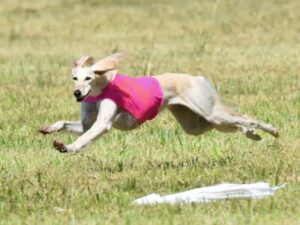
Follow Sophie’s remarkable journey in AKC Lure Coursing as a Saluki, showcasing the importance of evaluating sighthounds’ performance.

Starlite Salukis champions functional, ethical breeding, mentorship, and tradition – preserving the timeless Saluki legacy.

Lesley Brabyn is the breeder behind Timaru Kennels. Read about the kennel’s beginnings, the sires, the dams, the puppies, and much more!

Julie Mueller is the breeder behind Aurora Kennel. Read about the kennel’s beginnings, the sires, the dams, the puppies, and much more!

Interview with Hound Group Breeder D. Scott Pfeil – Wynsyr Kennels Where do I live? How many years in dogs? How many years

Interview with Hound Group Breeders Warren & Vicky Cook. Where did each of you grow up? We were both born in California.
The best way to ensure a long and happy relationship with a purebred dog is to purchase one from a responsible breeder. Not sure where to begin?
Contact the National Parent Club’s Breeder Referral Program, which is listed on the AKC Breeder Referral Contacts page.
